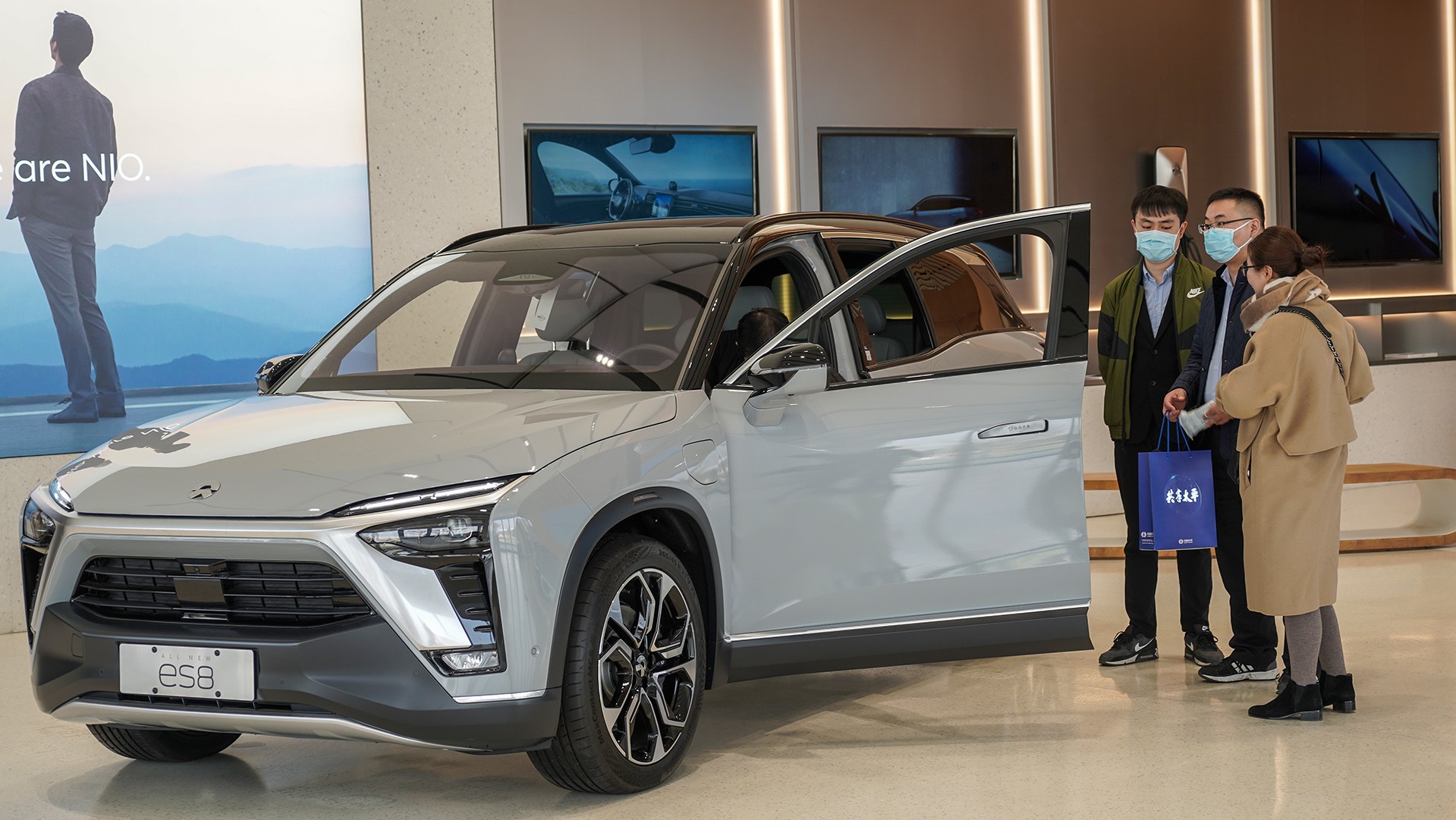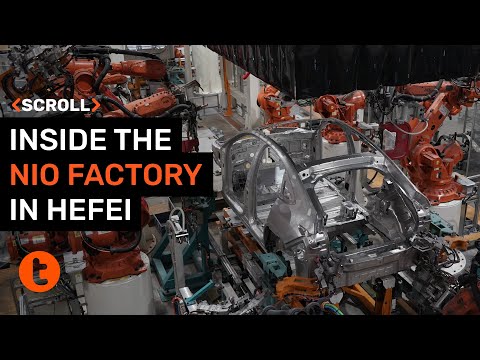Walk into NIO’s joint-venture factory grounds in Hefei, capital of China’s eastern Anhui province, and you might mistake it for a sprawling tech campus rather than an auto manufacturing plant. The factory sits next to a cluster of elegant, low-slung glass buildings, surrounded by a large, well-kept lawn.
The campus has become somewhat of a local icon, attracting interest beyond its employees, partly due to NIO House, the company’s expansive, clubhouse-style retail space and gallery located next to the plant. As customers peruse vehicles in the space or wait for a latte in the showroom’s café, a crossover rolls off the production line every two minutes, with the assistance of more than 300 robots, from assembly lines to painting.
Two weeks ago, TechNode paid a visit to NIO’s Hefei plant to view the production process and understand how it works. The plant itself is a scene of bustling activity—giant robotic arms work on production lines to assemble vehicles, while human employees conduct inspections on the final assembly line. Each vehicle varies in model, color, and configuration.
“Sometimes, in a month, no two vehicles leaving the factory are exactly alike,” (our translation) a company spokesperson told TechNode reporters.
When the EV maker received earlier this year a $1 billion funding lifeline led by the Hefei government, the city—a lesser-known automaking hub known for churning out lower-end sedans and trucks—got a major boost in return. Hefei is readying itself to spearhead China’s goal of becoming the world’s leading EV producer and consumer market and NIO, its best-known EV firm, is poised to ride the wave.
Futuristic factory
Located minutes from the city’s downtown, the 16-acre joint plant is the size of nine football fields and employs more than 2,000 workers—mostly technicians from its partner, state-owned automaker JAC Motors, as well as several hundred NIO engineers. Much of the landscaping still looks new after three years of operation. The two companies reached an outsourcing agreement in mid-2016.
The factory is well-organized and spotlessly clean. TechNode saw high levels of automation throughout the factory, with robots of all shapes and sizes waving their arms in various workshops. NIO boasts that all major vehicle components are assembled in a completely automated process.
A seamless human-robot collaboration powers the highly flexible, mixed-model production process and a made-to-order car business that allows customers to configure their cars “in a free style.” NIO said there is more than 200,000 different configurations, around 3,000 of which most popular with its customers. “This [customization process] was highly demanding in terms of error proofing… but we finally did it,” (our translation) Victor Gu, general manager of NIO’s Hefei Advanced Manufacturing Center, told TechNode.
Manufacturing ramps up
After delivering a cumulative 70,000 EVs to customers, the company is preparing an expansion that will increase output by 50% in January, amid rising domestic demand for luxury EVs. “We’ve seen substantial order growth in the second half of this year, sometimes by 30% to 50% in just one month, which is far faster than conventional production acceleration. Normally you need at least two to three months to improve existing production equipment,” (our translation) Gu said.
The company is on track to reach in January a monthly production goal of 7,500 vehicles, Gu added, and has stepped up output by 50% to 30 SUVs per hour starting this month. The Hefei factory has production capacity to build 120,000 vehicles per year with two labor shifts, and is capable of a 25% expansion “without significant investment,” according to CEO William Li during an earnings call in August.
Meanwhile, Tesla has reportedly (in Chinese) planned to more than double the annual capacity of its Gigafactory Shanghai to 550,000 units in 2021. Another Chinese EV maker, Xpeng Motors built its second plant in the southern Chinese city of Guangzhou and will be able to produce 350,000 EVs by the end of 2022, according to a Chinese media report.
Carmakers are aggressively expanding production as Chinese EV sales accelerate, with strong momentum expected in the next few years. UBS analysts estimated in a Dec. 11 research note that Chinese EV sales will surge 55% to 1.6 million units next year and maintain double-digit annual growth to reach more than 5.5 million units in 2025.
EV push in Hefei
Analysts are echoing China’s grand ambitions to hold a commanding lead in the global EV market. In a finalized blueprint issued Nov. 2, the central government said that new energy vehicles (NEVs)—namely electric, plug-in hybrid, and hydrogen-powered vehicles—would account for 20% of total car sales in 2025. This is equivalent to 5.15 million units, according to last year’s sales figures, and Hefei is one of several municipalities which has committed to supporting this vision.
Auto production in Hefei accounted for around 3% of China’s auto sales last year. Now, the local government has set a 2025 output target of 1 million NEVs, according to a document released last month (in Chinese). The government has high hopes for local EV makers, which it expects to “gain influence in the global market.” Hefei is also planning to build a local supply chain with at least 10 “hidden champions“—relatively unknown but globally competitive companies, in segments such as battery, powertrain, and Lidar.
While not unattainable, such a goal will require a hard push, and the city is beginning within its own borders. In Hefei’s recent stimulus program, the city will exempt EV drivers from payment in public parking lots and allow them to travel in the city’s bus lanes during off-peak hours. The government is planning to electrify all public transit starting next year, while the taxi fleet will be 100% electrified by 2025.
Historically known for manufacturing display panels and electronics, Hefei is now considered one of the country’s emerging EV capitals, surrounded by major industry players such as Volkswagen and its two manufacturing partners. Moreover, the city has had its own EV darling, with its RMB 7 billion ($1 billion) investment in NIO in April.
Hefei is not the only city with EV aspirations. Guangzhou, capital of southern Guangdong province, in September promised to be listed among the three biggest EV manufacturing bases in the country by making at least 1.5 million NEVs in 2025. As one of China’s auto manufacturing hubs and a foothold for Japanese auto giants Toyota and Honda, the southern gateway city is determined to stay ahead, and recently doubled down on EV startup Xpeng.
More local governments are playing catchup. Xi’an, the capital of northwestern Shaanxi province last week said it will extend government subsidies and tax exemptions on EVs to the end of 2022. Meanwhile, in central China, buyers of fully electric cars in Wuhan have been eligible since May for an additional RMB 10,000 rebate on top of Beijing’s subsidies.


